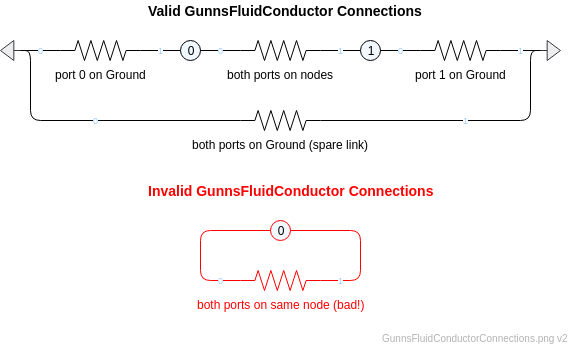GunnsBasicConductor - nasa/gunns GitHub Wiki

This link is the simplest conductor used in thermal and electrical networks and is the base class for some other conductors such as thermal radiations and constant power loads, etc. The link flows w in proportion to the node delta-potential dp as:
where G is the link's conductance. This is implements Ohm's Law for electrical networks:
since resistance R is the inverse of conductance G, and in electrical networks, potential is voltage V and flux is current I.
This also implements Newton's Cooling Law for thermal networks:
where h is thermal conductance, since in thermal networks flux is heat flux q and potential is temperature T.
This picture shows the various ways fluid conductors can be connected to nodes, and one way they can't. Putting both ports on Ground is a good way to store spare links. We're reusing the picture from fluid conductors as they have the same rules:

Port Connection Rules (These are limitations on the port connection to nodes that the link enforces in run-time):
- Ports 0 and 1 cannot connect to the same non-Ground node.
Other Rules (These are extra rules you should always try to follow):
- In general, try to combine conductors in series into a single conductor whenever possible.
This reduces the network node count, which can save a lot of CPU. Conductors in series combine
the same way as resistors in parallel. For example, two conductances G_1 and G_2 in series
can be represented as one conductance G_total as:
G_total = 1 / ( 1/G_1 + 1/G_2 ), (series conductors)
Similarly, conductors in parallel combine the same way as resistors in series, as:
G_total = G_1 + G_2, (parallel conductors)These relationships can help you merge series conductors and keep the performance of the overall chain the same.
Configuration Data Parameters:
- defaultConductivity (default = 0.0, must be >= 0 and in general you should limit non-zero values to be between 1.0E-15 and 1.0E+15): This is the maximum conductivity the link takes when it is not blocked. For electrical networks, this has units of (1/ohm), and for thermal networks, (W/K). The blockage malfunction (described below) further reduces the effective conductivity used in the flow equation from this maximum conductivity.
Input Data Parameters:
- malfBlockageFlag (default = false): Initial state of the blockage malfunction activation flag. This malfunction reduces the effective conductivity from the defaultConductivity value.
- malfBlockageValue (default = 0.0, must be (0-1)): Initial state of the blockage malfunction activation value. A value of 0.0 is the same as no blockage at all, and 1.0 completely blocks all flow and isolates the port nodes from each other (although parallel flow paths still apply). For electrical networks, a blockage of 1.0 is an open-circuit.
- N/A
- N/A